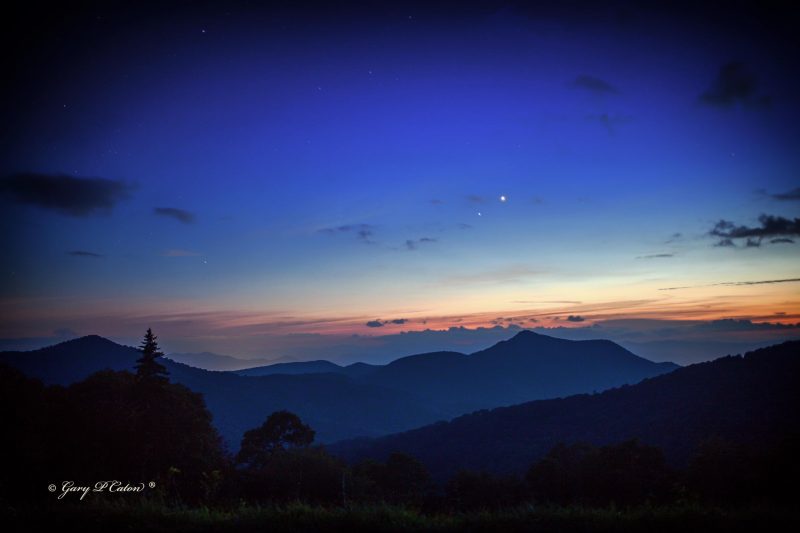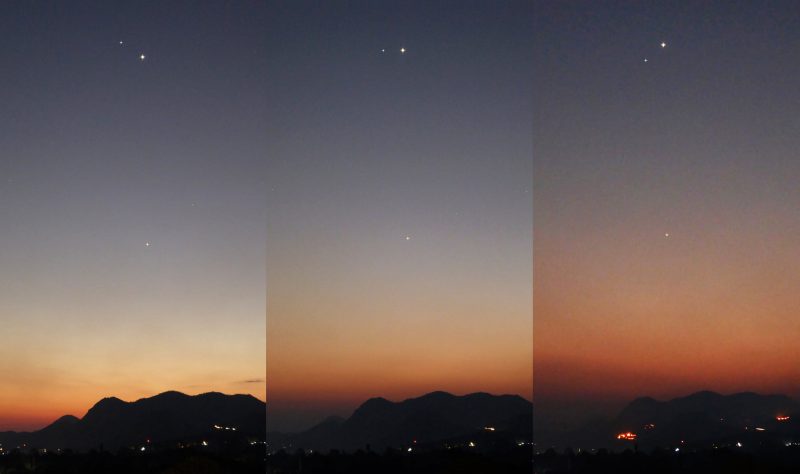
Venus-Spica conjunction
In early September 2021, you’ll see an exceedingly bright object above the western horizon. It’s the planet Venus. And perhaps you’ve noticed the little bright star shining near Venus. It’s not nearly as bright as the planet. But it’s noticeable, if you look, near the other, much-brighter world. The star is Spica in the constellation Virgo the Maiden. The Venus-Spica conjunction will come on September 5. But any of the coming evenings are excellent for watching this pair in the western twilight. Don’t wait too long. They’ll set soon after the sun.
Venus is the brightest planet and by far the brighter of the these two starlike points close together in the western twilight. Venus blazes away in your western sky some 30 to 45 minutes (or sooner) after sunset. Then, as dusk deepens into nightfall, watch for Spica, the constellation Virgo’s brightest star, to pop out close to Venus.

From most of the world, the twosome should become visible to the eye alone around 60 to 75 minutes after sunset. We except far-northern latitudes, where Venus and Spica will follow the sun below the horizon shortly after sundown.
Practiced sky watchers may well catch Venus as little as 10 to 15 minutes after sundown. After all, Venus ranks as the third-brightest celestial object to light up the heavens, after the sun and moon, respectively. Spica is an almost-perfect example of a 1st-magnitude star. Even so, Spica pales next to dazzling Venus, which shines a good hundred times more brilliantly than this blue-white gem of a star.
Venus setting times
The farther south you live on the globe, the longer that Venus and Spica stay out after dark. We give the approximate setting time for Venus, the much brighter of the two, for various latitudes:
60 degrees north latitude:
Venus sets 25 minutes after the sun40 degrees north latitude:
Venus sets 1 1/2 hours (90 minutes) after sunsetEquator (0 degrees latitude):
Venus sets 2 1/2 hours (150 minutes) after sunset35 degrees south latitude:
Venus sets 3 1/4 hours (195 minutes) after sunset
Want more specific information? Go to timeanddate.com (worldwide) or Old Farmer’s Almanac (U.S. and Canada)

Tilt of the ecliptic favors Southern Hemisphere
At sunset/dusk/nightfall on September evenings, the ecliptic – pathway of the sun, moon and planets – arcs highest overhead for the year in the Southern Hemisphere.
In the Northern Hemisphere, it’s the exact opposite. The ecliptic sinks lowest down for the year on September evenings.
That’s why Venus and Spica stay out so much longer after sunset from southerly latitudes, yet set so much sooner after sundown at northerly latitudes.
Still, no matter where you live worldwide, it’ll be to your advantage to find an unobstructed horizon in the direction of sunset. At far-northerly latitudes, you may need binoculars to see Venus and/or Spica taking stage in a single binocular field.

Bottom line: Enjoy the grand pairing of the sky’s brightest planet, Venus, and the constellation Virgo’s brightest star, Spica, in early September 2021.











